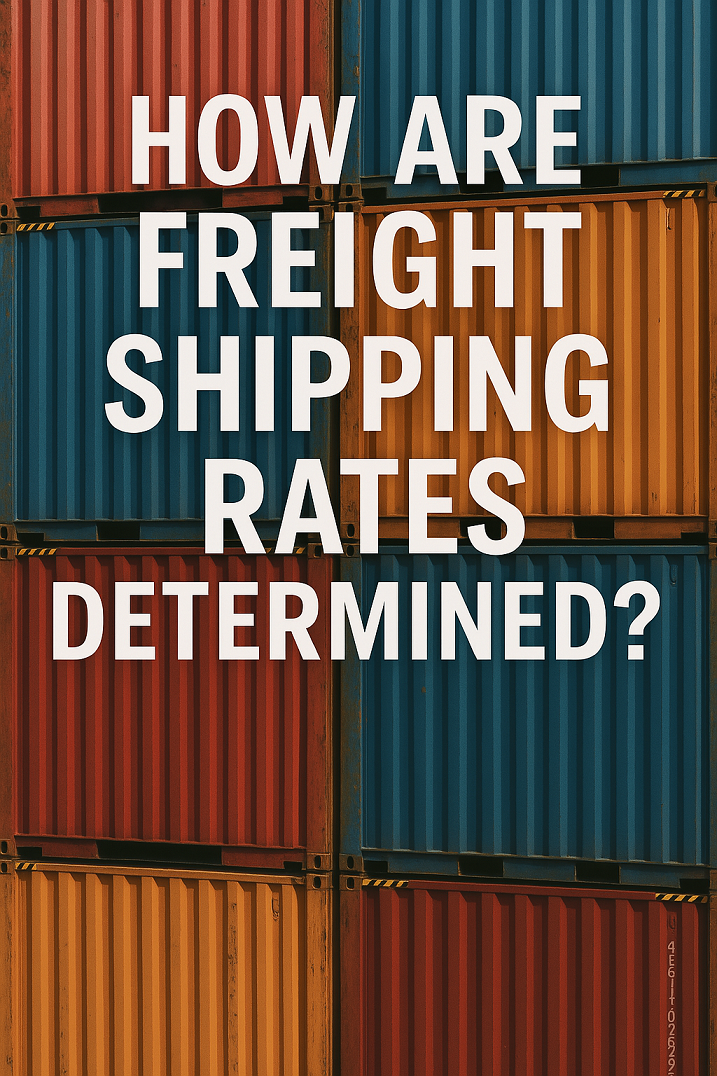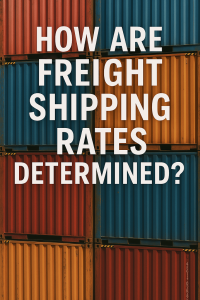Learn how shipping costs are calculated, including freight rate calculation methods, shipping cost per kg or container, LCL vs FCL pricing, and more. Ideal for maritime students, cadets, professionals, and logistics experts.
Why Freight Costs Are More Complex Than They Seem
Ever wondered why shipping a 20-foot container from Shanghai to Rotterdam can cost $1,000 one month and $4,000 the next? Whether you’re a maritime student, logistics manager, or shipping company executive, understanding how freight shipping rates are determined is critical for planning, budgeting, and operational efficiency.
This educational and SEO-optimized article explores:
- Key freight rate calculation methods
- LCL vs FCL pricing models
- Common shipping cost per kg or container
- The international freight cost guide for learners and professionals
What Is a Freight Rate?
A freight rate is the total cost charged by a carrier to move cargo from one location to another. It’s calculated based on weight, volume, distance, transport mode, cargo type, and other market-driven factors.
Freight rates apply to various shipment types:
- Full Container Load (FCL)
- Less than Container Load (LCL)
- Breakbulk, Ro-Ro, and bulk cargo
- Air and rail freight
Key Factors That Influence Shipping Costs
📦 1. Cargo Weight and Volume
-
Actual weight (gross weight): Measured in kilograms or metric tons
-
Volumetric weight: Based on dimensions (Length × Width × Height / 6000 or 5000)
💡 Whichever is higher—gross or volumetric weight—is used for billing.
🚢 2. Mode of Transport
-
Sea freight: Ideal for large, heavy cargo
-
Air freight: Faster, but more expensive (per kg)
-
Rail and truck freight: Used for inland or intermodal shipping
🌍 3. Shipping Route and Distance
-
Direct vs transshipment routes
-
Congestion at ports or trade lanes
-
Political or environmental risks (e.g., Red Sea conflict, Suez Canal blockage)
🧾 4. Fuel Surcharges and Bunker Adjustment Factors (BAF)
These are adjusted based on global oil prices and fuel type compliance (e.g., IMO 2020 low sulfur rules).
⚓ 5. Port and Handling Fees
-
Terminal Handling Charges (THC)
-
Container Freight Station (CFS) fees
-
Documentation, customs clearance, and storage fees
📈 6. Market Demand and Capacity
-
Peak season surcharges (e.g., pre-holiday periods)
-
Freight rate fluctuations due to space availability
Freight Rate Calculation Methods
SEO Keyword: freight rate calculation methods
Method #1: Cost Per Kilogram (Air or Express Freight)
Formula:
📦 Rate = Total Weight (kg) × Cost per kg
Example: 300 kg shipment at $5.50/kg → $1,650 total cost
Method #2: Cost Per Container (FCL)
Freight carriers offer flat rates for:
-
20-foot container (TEU)
-
40-foot container (FEU)
-
40 HC (High Cube) or reefer containers
Example: Asia–Europe 40-ft FCL → $2,500 (all-in rate)
Method #3: LCL Pricing (Less than Container Load)
LCL rates are calculated per CBM (Cubic Meter):
-
Minimum charges apply for 1 CBM
-
Shared container space leads to consolidated pricing
Formula:
📦 Rate = Volume (CBM) × Cost per CBM + Local Charges
Example: 3 CBM at $90/CBM + $75 CFS charge → $345
Method #4: Freight Class (U.S. Ground Freight Only)
In North America, freight classes (50–500) are used based on:
-
Density
-
Stowability
-
Handling
-
Liability
LCL vs FCL Pricing: Which Is Cheaper?
SEO Keyword: LCL vs FCL pricing
| Feature | LCL (Less than Container Load) | FCL (Full Container Load) |
|---|---|---|
| Cargo Volume | <15 CBM | >15 CBM |
| Cost | Charged per CBM + fees | Flat container rate |
| Handling | More touchpoints | Direct and secure |
| Transit Time | Slightly longer (consolidation) | Shorter |
| Best For | Small/medium businesses | Large volume shippers |
✅ Rule of Thumb: If shipping more than 15 CBM, FCL is usually more cost-effective.
Shipping Cost Per KG or Container: Average Rates
| Route | Mode | Avg. Cost per KG | 20ft Container | 40ft Container |
|---|---|---|---|---|
| Shanghai → Los Angeles | Sea FCL | N/A | $1,800 | $2,800 |
| Mumbai → Dubai | Sea LCL | $0.25–$0.40 | $900 | $1,600 |
| Frankfurt → New York | Air | $4.50–$7.00 | N/A | N/A |
| Rotterdam → Singapore | Sea FCL | N/A | $1,500 | $2,400 |
📊 Rates vary based on season, fuel prices, and global supply chain disruptions.
International Freight Cost Guide (2025 Outlook)
SEO Keyword: international freight cost guide
💡 Pro Tips for Managing Costs:
-
Book in advance to avoid peak surcharges
-
Use freight consolidators for LCL shipping
-
Optimize packaging to reduce dimensional weight
-
Leverage freight forwarders for better deals and route planning
-
Consider Incoterms (e.g., FOB, CIF) when negotiating
🔍 Current Challenges Affecting Rates:
-
Container shortages in key ports
-
Geopolitical disruptions (Red Sea, Ukraine, Taiwan Strait)
-
Carbon emissions taxes and sustainability levies
-
Green shipping compliance costs
Real-World Application & Case Study
A mid-sized Italian wine exporter ships 12 pallets (8 CBM, 1.8 tons) to Canada monthly. Initially using LCL, the cost was ~$1,200/month. By switching to FCL and consolidating orders every two months, they reduced average cost per pallet by 20%, while improving transit time and product security.
FAQs: People Also Ask
How are shipping costs calculated?
Shipping costs are based on weight, volume, route, mode, port fees, and current market rates. FCL uses flat container rates, while LCL is billed per CBM.
What is the difference between LCL and FCL pricing?
LCL is shared container space billed per CBM; FCL is a flat rate for an entire container. LCL is best for small shipments; FCL for high-volume cargo.
What affects international freight cost the most?
Fuel prices, global demand, port congestion, and seasonal trends are top influencers.
How much does it cost to ship a container overseas?
A 20-ft container costs between $1,000–$3,000, depending on the origin, destination, and current shipping conditions.
Conclusion: Understanding Freight Costs Is Essential to Global Trade
Whether you’re analyzing shipping for an academic project, budgeting for exports, or managing large-scale maritime operations, understanding how freight shipping rates are determined gives you a strategic edge.
From freight rate calculation methods to LCL vs FCL pricing, mastering the dynamics behind these charges empowers better decisions—and ensures smoother, more cost-effective shipments.
⚓ Explore Further:
References & Further Reading
-
UNCTAD – Review of Maritime Transport: unctad.org
-
Freightos International Freight Index: freightos.com
-
Drewry Shipping Research Reports: drewry.co.uk
-
“Shipping and Freight Resource” Industry Blog



Everything worked just as you described. You’re one of the few writers I actually trust with these types of guides. Thanks for taking the time to share this.